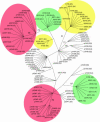Concerted evolution in the repeats of an immunomodulating cell surface protein, SOWgp, of the human pathogenic fungi Coccidioides immitis and C. posadasii
- PMID: 15965255
- PMCID: PMC1456504
- DOI: 10.1534/genetics.105.040923
Concerted evolution in the repeats of an immunomodulating cell surface protein, SOWgp, of the human pathogenic fungi Coccidioides immitis and C. posadasii
Abstract
Genome dynamics that allow pathogens to escape host immune responses are fundamental to our understanding of host-pathogen interactions. Here we present the first population-based study of the process of concerted evolution in the repetitive domain of a protein-coding gene. This gene, SOWgp, encodes the immunodominant protein in the parasitic phase of the human pathogenic fungi Coccidioides immitis and C. posadasii. We sequenced the entire gene from strains representing the geographic ranges of the two Coccidioides species. By using phylogenetic and genetic distance analyses we discovered that the repetitive part of SOWgp evolves by concerted evolution, predominantly by the mechanism of unequal crossing over. We implemented a mathematical model originally developed for multigene families to estimate the rate of homogenization and recombination of the repetitive array, and the results indicate that the pattern of concerted evolution is a result of homogenization of repeat units proceeding at a rate close to the nucleotide point mutation rate. The release of the SOWgp molecules by the pathogen during proliferation may mislead the host: we speculate that the pathogen benefits from concerted evolution of repeated domains in SOWgp by an enhanced ability to misdirect the host's immune system.
Figures


Similar articles
-
A parasitic phase-specific adhesin of Coccidioides immitis contributes to the virulence of this respiratory Fungal pathogen.Infect Immun. 2002 Jul;70(7):3443-56. doi: 10.1128/IAI.70.7.3443-3456.2002. Infect Immun. 2002. PMID: 12065484 Free PMC article.
-
Positive directional selection in the proline-rich antigen (PRA) gene among the human pathogenic fungi Coccidioides immitis, C. posadasii and their closest relatives.Mol Biol Evol. 2004 Jun;21(6):1134-45. doi: 10.1093/molbev/msh124. Epub 2004 Mar 19. Mol Biol Evol. 2004. PMID: 15034131
-
A metalloproteinase of Coccidioides posadasii contributes to evasion of host detection.Infect Immun. 2005 Oct;73(10):6689-703. doi: 10.1128/IAI.73.10.6689-6703.2005. Infect Immun. 2005. PMID: 16177346 Free PMC article.
-
Genomics in Coccidioides: insights into evolution, ecology, and pathogenesis.Med Mycol. 2014 Feb;52(2):149-55. doi: 10.1093/mmy/myt001. Epub 2013 Dec 12. Med Mycol. 2014. PMID: 24576996 Review.
-
The population biology of coccidioides: epidemiologic implications for disease outbreaks.Ann N Y Acad Sci. 2007 Sep;1111:147-63. doi: 10.1196/annals.1406.040. Epub 2007 Mar 7. Ann N Y Acad Sci. 2007. PMID: 17344537 Review.
Cited by
-
T2prhd: a tool to study the patterns of repeat evolution.BMC Bioinformatics. 2008 Jan 18;9:27. doi: 10.1186/1471-2105-9-27. BMC Bioinformatics. 2008. PMID: 18205906 Free PMC article.
-
Controlled chaos of polymorphic mucins in a metazoan parasite (Schistosoma mansoni) interacting with its invertebrate host (Biomphalaria glabrata).PLoS Negl Trop Dis. 2008;2(11):e330. doi: 10.1371/journal.pntd.0000330. Epub 2008 Nov 11. PLoS Negl Trop Dis. 2008. PMID: 19002242 Free PMC article.
-
Comparative transcriptomics of the saprobic and parasitic growth phases in Coccidioides spp.PLoS One. 2012;7(7):e41034. doi: 10.1371/journal.pone.0041034. Epub 2012 Jul 20. PLoS One. 2012. PMID: 22911737 Free PMC article.
-
Rapid molecular diversification and homogenization of clustered major ampullate silk genes in Argiope garden spiders.PLoS Genet. 2022 Dec 12;18(12):e1010537. doi: 10.1371/journal.pgen.1010537. eCollection 2022 Dec. PLoS Genet. 2022. PMID: 36508456 Free PMC article.
-
Fungal Pathogens: Shape-Shifting Invaders.Trends Microbiol. 2020 Nov;28(11):922-933. doi: 10.1016/j.tim.2020.05.001. Epub 2020 May 27. Trends Microbiol. 2020. PMID: 32474010 Free PMC article. Review.
References
-
- Anderson, R. P., and J. R. Roth, 1979. Gene duplication in bacteria: alteration of gene dosage by sister-chromosome exchanges. Cold Spring Harbor Symp. Quant. Biol. 43(2): 1083–1087. - PubMed
-
- Burt, A., D. A. Carter, G. L. Koenig, T. J. White and J. T. Taylor, 1995. A safe method of extracting DNA from Coccidioides immitis. Fungal Genet. Newsl. 42: 23.
-
- Charlesworth, B., P. Sniegowski and W. Stephan, 1994. The evolutionary dynamics of repetitive DNA in eukaryotes. Nature 371: 215–220. - PubMed
Publication types
MeSH terms
Substances
Grants and funding
LinkOut - more resources
Full Text Sources
Other Literature Sources

